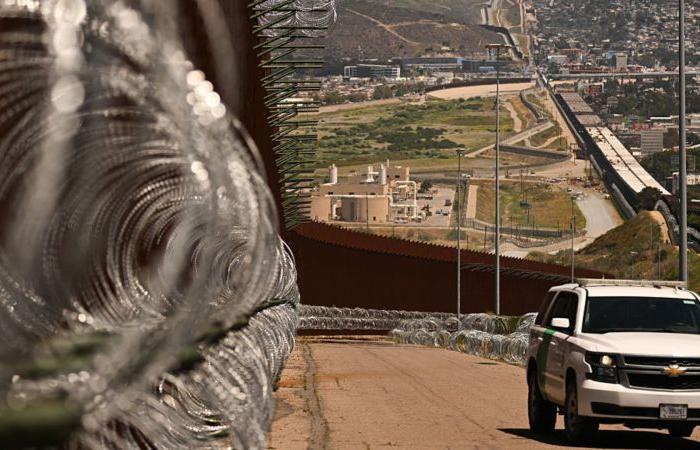
CNN Español
—
President Donald Trump reached his first 100 days of government with the lowest levels of migrant meetings on the southern border compared to previous years, a decrease attributed to its marked policy against illegal immigration, which has included mass deportations, reduction of humanitarian and legal roads to enter the country, the disqualification of the CBP One application and a greater military presence in the border.
Although this drop in migratory flows is presented as an early victory for Trump administration under its standards, experts consulted by CNN indicate that it could have long -term consequences that include greater illegal traffic of people trying to cross the border, a bucket effect – a rebound, that after the initial decrease there is an increase – and the inability of third countries to solve the needs of migrants.
From January 20 to April 29, the Trump government implemented 181 specific executive measures for immigration, exceeding the 94 measures of the first 100 days of the Biden government, according to an analysis of the Institute of Migration Policy (MPI).
Since the first days of Trump’s second term, the so -called Tsar of the Border, Tom Homan, presumed the figures of immigrants. “229 meetings in a 24 -hour period, that is a record,” he said. “Compare it with 11,000 per day under Biden (…) I started the border patrol in 1984, I had never seen these numbers, that is a record,” he said.
In January, 61,448 meetings were registered on the southern border, which represented a considerable decrease compared to January 176,195, 2024, according to the data of the United States Customs and Border Protection Office (CBP). Although of that period, only the last 10 days were part of the Trump administration.
The figures were even lower in February, when 11,709 matches were recorded, and remained downward in March with 11,017, which meant a remarkable fall compared to 189,913 and 189,359 of the same months of last year, respectively, according to CBP.
The arrests of the border patrol also increased. In February, the first full month of the Trump administration, 8,346 undocumented immigrants were recorded, an average of 330 arrests per day. While, in March, the figure decreased to 7,181, according to official data.
At the end of April, Homan assured that the Trump government has deported 139,000 undocumented immigrants since January 20. “Am I happy with the number? The numbers are good, especially if you look at the ICE numbers,” he said.
Dr. Javier Urbano, academic and researcher of the Department of International Studies of the Ibero -American University and a specialist in immigration policies, compares the fall in the arrival of migrants to the border with an inflated balloon to which the nozzle closes.
“If the shore is closed where the air comes out, eventually it will begin to be released. The policy against Trump’s immigration is retaining migrants in a geographical part of Latin America, it is encapsulating them in such a way that the migratory phenomenon is only arrested, but as soon as any situation is opened, migration will increase again as a rebound effect,” he said.
This happened during Trump’s first government. During the first 100 days of his government, border crossings decreased, but increased in the following years of their administration and reached their highest point in 2019, with 997,509 arrests, compared to 415,517 of 2017, according to CBP figures.
“The conjunctures in the United States are constant and periodic and depend, to a large extent, on the environment promoted by a person in the country. It is a latent phenomenon that will resume its dynamics,” said Urban.
This opinion is also shared by Sandra Hernández, director of Sin Bordras, a civil organization in Mexico that works for the human rights of migrants, who told CNN that at the time an entrance window to the United States is opened, “a rebound effect will occur because people are waiting to move.”
However, he said that this effect can occur at any time due to the uncertainty and misinformation that migrants face. “There are many false news that come to migrants through groups and communities that form themselves in which they share information on alleged opportunities to reach the United States, although it is often a lie and this also generates those increases in the attempts at border crossings,” he said.
Indocumented migration policies will also have greater illegal traffic of people seeking to fulfill the so -called American dream despite the dangers they face, according to analysts.
“When measures against undocumented immigration are applied, migratory routes become much more guarded by the authorities, causing migrants to be orillas to look for more dangerous paths,” said Hernández, and added that these excessive migration brakes will not avoid in any way that the population continues to migrate.
Urban explains that the groups of migrants who are somewhere in the American continent will be prey to traffickers who are going to ask for more money to take people to the United States.
“In their anguish, they will be looking for economic alternatives to pay the trafficker, which will enrich and strengthen organized crime,” he said.
Every year, between 200,000 and 400,000 migrants from Central America are trafficked from Mexico to the US, according to estimates of the United Nations Office against Drug and Crime (UNODC).
As promised in the campaign, Trump began the deportation of undocumented immigrants through military flights. “This is not sustainable in the long term,” says Hernández, from Sin Borders.
“The third countries where deportened immigrants are sent do not have security tools, attention, nor the necessary resources to solve their basic needs. Not having security mechanisms are exposed to organized crime, extortion or kidnappings,” he says.
Undocumented migrants usually leave their countries of origin for various reasons such as a better life for themselves or for their families, the search for a job, getting out of poverty, natural disasters or fleeing violence or persecution.
“We have a problem of lack of work spaces for these groups and this will eventually generate tensions that have to do with a poorly managed migration in all mobility cycles from the country that does not give it resources to stay, the country that rejects them and the country to which they are deported,” said Urbano, of the Ibero -American University.
Although countries such as Mexico, Guatemala and Honduras have implemented policies for receiving and reintegration of migrants, an analysis of the Institute of Migration Policy states that “these programs have been largely ineffective to improve the long -term conditions of the returnees, often the same ones that prompted them to emigrate.”
Urbano details that, if the objective of deportation is to deter future attempts for irregular migration to the United States, it is necessary to guarantee the economic, social and cultural integration of the returnees in a shared effort between the US government and the recipient countries.
A growing number of Americans thinks that the deportation policies of President Trump have gone too far, according to a CNN survey conducted by SSRS.
Little more than half (52 %) states that Trump has gone too far by deporting undocumented immigrants, compared to 45 % in February. A similar percentage (52 %) now states that Trump’s immigration policies have not caused the United States to be safer. And the majority (57 %) claim not to believe that the federal government is fulfilling the law by carrying out deportations.
“In general terms of migration the trend was reversed because in this, people in general think of due process,” Octavio Pescador, a professor at the University of Los Angeles, California, told CNN.
The Trump government has resorted to hundred laws to quickly deport undocumented immigrants such as the Law of Foreign Enemies, of 1798, which was only used in times of war, something that has generated criticisms of immigration experts for fear of a possible erosion in the rights to due process of migrants so that their cases are reviewed.
In addition, I send dozens of immigrants to the Naval Base of the Bay of Guantanamo, Cuba, an unprecedented measure that triggered a fierce reaction by immigrant defenders.
The measures involve a drastic change in immigration policy that, in turn, sends a message to undocumented immigrants so that they do not try to enter the United States.
“The coming months will reveal whether these initial actions represent the culminating point of the administration immigration agenda or simply the initial chapter of a more comprehensive transformation of the United States immigration system,” says a Laurence Benenson and Nicci Mattey analysis of the NGO National Immigration Forum, dedicated to the defense of immigrants.





